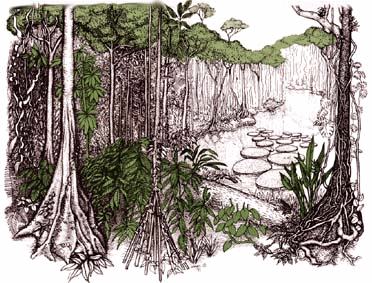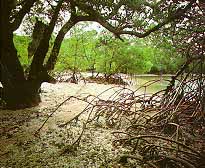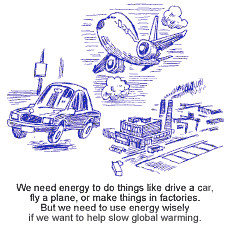By: Deanna Coon

Table of Contents
- Introduction
- What is Global warming?
- What causes global warming?
- What is an ecosystem
- Florida's Ecosystems
- What are the effects of global warming on ecosystems?
- What can be done
The
world's ecosystems are in high danger from the effects of global warming.
Many things are contributing to the loss of the ecosystem's species, plants,
and water. This web page will inform about ecosystems and how they
are being destroyed by global warming.
What is global warming?
Global
warming is the increase in the Earth's temperature caused by the buildup
of greenhouse gases in the atmosphere such as carbon dioxide, methane,
and  nitrogen.
Greenhouse gases prevent infrared radiaiton from escaping into space and
those gases maintain the earth's warm temperature. The increasing
levels of greenhouse gases resulting from industry and buring of fossil
fuels is likely to result in rising global temperatures. This rise
in temperature is causing each year to have higher temperatres. Warming
in the 20th century has been greater than any other time in the past 400-600
years.
nitrogen.
Greenhouse gases prevent infrared radiaiton from escaping into space and
those gases maintain the earth's warm temperature. The increasing
levels of greenhouse gases resulting from industry and buring of fossil
fuels is likely to result in rising global temperatures. This rise
in temperature is causing each year to have higher temperatres. Warming
in the 20th century has been greater than any other time in the past 400-600
years.
What
causes global warming?

gLOBALWARMING
IS CAUSED BY THE ENTRAPMENT OF HEAT THROUGH GREENHOUSE GASES. tHOSE
GASES KEEP THE HEAT THAT ENTERS THE ATMOSPHERE TRAPPED, THEREFORE CREATING
A BUILDUP OF HEAT. tHERE ARE A TOTAL OF ABOUT 40 GREENHOUSE GASES,
BUT CARBON DIOXIDE IS THE MAIN CONTRIBUTER TO THE GLOBAL WARMING.
ALSO AS HEAT INCREASES IN THE ATMOSPHERE, SO DOES WATER VAPOR. tHE
HIGHER TEMPERATURES EVAPORATE MORE WATER AND THE WATER VAPOR TRAPS THE
HEAT IN THE ATMOSPHERE AS WELL.
What is an Ecosystem?
The
definition of an ecosystem is a functional unit that results from interactions
of abiotic, biotic, and anthropogenic components and are a combination
of interacting, interrelating parts that form a unitary whole. Ecosystems
vary in  size.
They can be as small as a puddle, or as large as the earth itself.
Basically, any living and non-living things interacting together can be
considered an ecosystem. Within each ecosystem, there are habitats
that vary in size. A habitat is a place where a population lives.
A population is a group of living organisms of the same kind living in
the same place at the same time. Natural ecosystems are made up of
abiotic factors such as air, water, rocks, and energy and biotic factors
such as plants, animals, and microorganisms.
size.
They can be as small as a puddle, or as large as the earth itself.
Basically, any living and non-living things interacting together can be
considered an ecosystem. Within each ecosystem, there are habitats
that vary in size. A habitat is a place where a population lives.
A population is a group of living organisms of the same kind living in
the same place at the same time. Natural ecosystems are made up of
abiotic factors such as air, water, rocks, and energy and biotic factors
such as plants, animals, and microorganisms.
Florida's Ecosystems
Florida has many ecosystems, but the three main ones are the Everglades, Big Cypress Swamp, and the Keys. The Big Cypress Swamp is part of the broad, shallow river moving freshwater south into the Everglades. The Keys, however, mark the last outposts of the Everglades lands. The Everglades have been named as the largest remaining subtropical wilderness in the United States. There is a massive diversity of plants and animals, and no other place is so well-defined by annual droughts and floods, fire, sunshine, and rain. The Everglades are becoming extinct more and more every day. The Big Cypress Swamp extends through thousands of acres from southwest of Lake Okeechobee to the Ten Thousand Islands in the Gulf of Mexico. It is considered to have the best quality surface water in south Florida. Thousands of acres are ditched, drained, subdivided, and sold for residential development or for agricultural use. The Florida Keys is a chain of small islands that extend to the southwest coast of south florida. There is many wildlife in the Keys, such as alligators, loggerhead turtles, waterbirds, crocodiles, manatees, and Key deer leaving these precious species to become extinct from the global warming.

What are the Effects of global warming on the ecosystems?
With global warming on the rise, and species and habitats decreasing, the chances for ecosystems adapting naturally are diminishing. Many different parts of ecosystems are being affected. Global warming could have many impacts on fish and other aquatic species. Some bodies of water may become too warm for the fish who inhabit that area. The global warming can also change the chemical composition of water, therefore the amount of oxygen in the water may decline, leaving pollution and salinity levels to increase. more than 20% of world's freshwater fish have become extinct, endangered, or threatened in the recent decades. A 20 inch sea level rise will cause large losses of mangroves in southwest Florida and communities of wet praire will decline with the rise of that sea level. Increased salinity would occur from rising saltwater into the Everglades from the Florida Bay. The increase in salinity would damage freshwater ecosystems that contain sawgrass and slough. Water is also undoubtedly a natural resourse that is essential for the maintainance of ecosystem viability. Precipitation will change dramatically along with other local climate conditions. Plants also have little ability to adapt to the changing climate. If global warming continues to grow- growing seasons, rainfall patterns, storms, and cycles of flood and drought will occur causing rapid changes in the range and distribution of plants worldwide. Scientists have proven that global warming is real and under way. The effects on the Earth's ecosystem could be devastating. All plants and animals everywhere will be affected in some way.

WHAT CAN BE DONE?????
The Kyoto protocol is something that has been created to help with the
issue of global warming. World leaders gathered in Kyoto, japan in
December of 1997 to  discuss
a world treaty restricting emissons of greenhouse gases which are thought
to be the cause of the global warming. The protocol has still not
gone into effect due to binding circumstances such as the cost and whether
we really need it. Scientists have been proving that global warming
is real and something needs to be done about it. As citizens of the
United States, it is our duty to help keep the environment in shape.
Humans can do a number of things such as- driving efficiently by carpooling,
taking public transit, riding a bicycle, or even walking. The burning
of the engines cause heat and fuels to get trapped in the atmosphere.
We should use compact fluorescent light bulbs which stat lit longer and
don't use as much energy. Groups can get together to plant a tree
and help save the forests. The public should also contact local officials
and urge them to support the efforts to reduce U.S. greenhouse emmissions.
This is our planet and if we don't do something soon, drastic effects will
occur. So, get involved and learn about global warming and the deadly
effects in has on our precious ecosystems!!!!
discuss
a world treaty restricting emissons of greenhouse gases which are thought
to be the cause of the global warming. The protocol has still not
gone into effect due to binding circumstances such as the cost and whether
we really need it. Scientists have been proving that global warming
is real and something needs to be done about it. As citizens of the
United States, it is our duty to help keep the environment in shape.
Humans can do a number of things such as- driving efficiently by carpooling,
taking public transit, riding a bicycle, or even walking. The burning
of the engines cause heat and fuels to get trapped in the atmosphere.
We should use compact fluorescent light bulbs which stat lit longer and
don't use as much energy. Groups can get together to plant a tree
and help save the forests. The public should also contact local officials
and urge them to support the efforts to reduce U.S. greenhouse emmissions.
This is our planet and if we don't do something soon, drastic effects will
occur. So, get involved and learn about global warming and the deadly
effects in has on our precious ecosystems!!!!
REFERENCES
http://www.epa.gov/globalwarming/
http://www.fi.edu/tfi/units/life/habitat/habitat.html
http://www.panda.org/resources/publications/climate/speedkills/
http://www.sierraclub.org/globalwarming/habitat/aquatic.asp
http://weather.about.com/cs/globalwarming/index.htm?iam=dpile&terms=global+warming